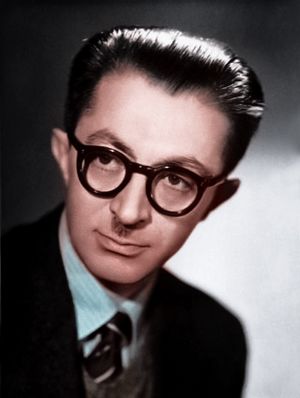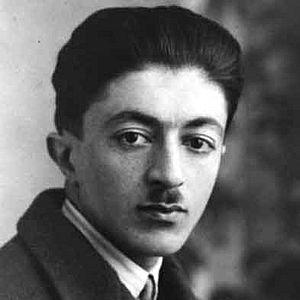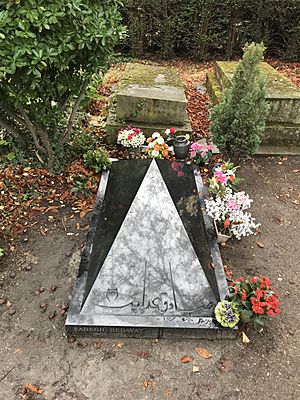Sadegh Hedayat facts for kids
Quick facts for kids
Sadegh Hedayat
|
|
|---|---|

The last photograph he posted from Paris to his relatives in Tehran. (1951)
|
|
| Born | 17 February 1903 Tehran, Imperial Iran
|
| Died | 9 April 1951 (aged 48) Paris, France
|
| Resting place | Père Lachaise Cemetery |
| Alma mater | Dar ul-Funun St. Louis School University of Tehran |
| Known for | Writer of prose fiction and short stories |
|
Notable work
|
The Blind Owl (Bufe kur) Buried Alive (Zende be gur) The Stray Dog (Sage velgard) Three Drops of Blood (Seh ghatreh khoon) |
Sadegh Hedayat (Persian: صادق هدایت; 17 February 1903 – 9 April 1951) was a very important Iranian writer and translator. He is most famous for his novel The Blind Owl. He was one of the first Iranian writers to use a new, modern style of writing in his books.
Contents
Early Life and Education
Sadegh Hedayat was born in Tehran, Iran, into a well-known family. His family had many writers and people who worked in the government. For example, his great-grandfather, Reza-Qoli Khan Hedayat Tabarestani, was a respected writer and worked for the government. His sister married a general who later became a prime minister under Shah Mohammad Reza Pahlavi. Another sister married an army general too.
Hedayat went to school at Collège Saint-Louis (a French school) and Dar ol-Fonoon from 1914 to 1916. In 1925, he was one of a few students chosen to study in Europe. He first went to Belgium to study engineering, but he changed his mind after a year. Then he tried architecture in France, and later dentistry. During this time, he met Thérèse, a girl from Paris. After four years in France, he returned home in 1930 without finishing his degree. Back in Iran, he worked different jobs for short periods.
Sadegh Hedayat's Writing Journey
Hedayat spent his life studying books from the West and learning about Iranian history and old stories. He especially liked the writings of famous authors like Rainer Maria Rilke, Edgar Allan Poe, Franz Kafka, Anton Chekhov, and Guy de Maupassant.
During his writing career, Hedayat wrote many short stories and novels. He also wrote two historical plays, a travel book, and a collection of funny stories. He wrote about literature, Iranian old stories, and translated many works from Middle Persian and French. People say that Hedayat helped bring Persian language and literature to the world stage. He was truly the most modern writer in Iran.
Later in his life, Hedayat became worried about the problems in Iran, especially with the government. He felt alone and misunderstood, even by his friends. His last published work, The Message of Kafka, shows his sadness and feeling of doom.
Hedayat traveled to India and stayed there from 1936 to 1937. In Bombay, he learned the Pahlavi language from the Parsi Zoroastrian community. He was taught by a famous scholar named Bahramgore Tahmuras Anklesaria. While in Bombay, Hedayat finished and published his most famous book, The Blind Owl. He had started writing this book in Paris in 1930. Famous writers like Henry Miller and André Breton praised the book. It is considered one of the most important books in the Persian language.
His Beliefs and Legacy
Vegetarianism
Hedayat was a vegetarian from a young age. He even wrote a book called The Benefits of Vegetarianism in 1927 while he was in Berlin.
His Final Years
In 1951, feeling very sad, Hedayat left Tehran and went to Paris. He rented an apartment there. A few days before he died, Hedayat destroyed all of his stories that had not been published yet. Two days later, the police found his body. He had left a note for his friends that said, "I left and broke your heart. That is all." He is remembered as a major symbol of Iranian nationalism.
The English poet John Heath-Stubbs wrote a poem for Sadegh Hedayat called "A Cassida for Sadegh Hedayat" in 1954.
Challenges and His Works
Censorship
In November 2006, the government in Iran banned new copies of Hedayat's uncensored books. This was part of a big ban on many books. However, it is still possible to find his original books second-hand. His official website is also still online.
Main Works
Here are some of Sadegh Hedayat's most important works:
- Stories
- 1930 Buried Alive (Zende be gūr) - A collection of 9 short stories.
- 1932 Three Drops of Blood (Se qatre khūn) - A collection of 11 short stories.
- 1936 The Blind Owl (Boof-e koor) - His most famous novel.
- 1942 The Stray Dog (Sag-e velgard) - A collection of 8 short stories.
- 1945 The Pilgrim (Hājī āqā)
- 1947 The Pearl Cannon (Tūp-e Morvari)
- Plays
- Parvin, Sassan's Daughter
- Māzīyār
- Travel Books
- Isfahan: Half of the World
- Studies and Other Writings
- The Advantages of Vegetarianism (1927)
- The Message of Kafka (1948)
- Translations from French
- 1931 Gooseberries by Anton Chekhov
- 1948 In the Penal Colony by Franz Kafka
- 1950 The Metamorphosis by Franz Kafka
- 1950 The Wall by Jean-Paul Sartre
- Translations from Middle Persian (Pahlavi)
- 1943 The Book of the Deeds of Ardashir Papakan
Films About Sadegh Hedayat
Several films have been made about Sadegh Hedayat and his works:
- In 1987, Raul Ruiz made a film in France called La Chouette aveugle. It was based on Hedayat's novel The Blind Owl.
- A short film called The Sacred and the Absurd was made about Hedayat's last day and night. It was shown at the Tribeca Film Festival in 2004.
- In 2005, Iranian director Khosrow Sinai made a film called Goftogu ba saye = Talking with a shadow. This film explored how Western movies like Der Golem and Nosferatu influenced Hedayat.
- In 2009, Mohsen Shahrnazdar and Sam Kalantari made a documentary film about Sadegh Hedayat called From No. 37.
See also
 In Spanish: Sadeq Hedayat para niños
In Spanish: Sadeq Hedayat para niños
- Intellectual movements in Iran
- Persian literature
- Persian philosophy




